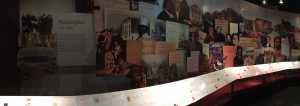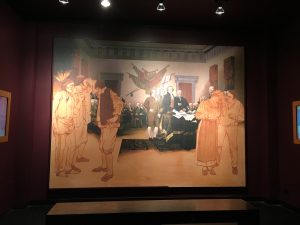The title for this piece is sourced from the song “No John Trumbull” from the Hamilton Mixtape. Watch if performed here.
Located near Chinatown in Old City, the African American Museum in Philadelphia (AAMP) is the first institution built by a major US city to preserve, interpret, and exhibit African American culture. Across from the museum are two federal buildings: the Federal Detention Center and the Federal Reserve Bank of Philadelphia. The museum consists of four galleries; currently, they have two art exhibits and two history exhibits. On display on the first floor of the museum is “Audacious Freedom: African Americans in Philadelphia: 1776-1876.” This exhibit attempts to tell the history of African Americans in Philadelphia through photos, light projections, a timeline, and audio. It answers questions museumgoers may have about African American culture in Philadelphia and the contributions they made to not only the abolitionist movement but also the city’s history.
The main display is a timeline that spans the years 1776 to 1876. The timeline is bolted to the floor, and, though presented chronologically, events are grouped into themes such as political activism and law and race. For each theme, there is an overview of the related events and a handful of related documents and portraits with descriptions. The documents and paintings on the timeline correspond to the pictures mounted on the wall; these pictures are arranged in a collage. None of the documents or photos presented on the timeline were physically on display in the museum: they belong to and are archived in other institutions; for example, there are pictures of petitions from the Society of Friends and Pennsylvania Abolition Society to abolish slavery, but the actual documents are in the National Archives. It would have been more engaging to have the real document or a copy of the document on display in the exhibit, so museumgoers could feel more connected to the exhibit’s historical narrative.
Though the physical documents and portraits are not on display, the museum uses the pictures on the wall to their advantage. There is a kiosk in the middle of the room with six themes to choose from on the screen: family, work, religion, culture, lives, and politics. When a theme is chosen, the lights over the timeline dim and projectors on the ceiling play a short film describing racial issues related to that theme. When a document or historical figure is mentioned, the corresponding picture on the wall lights up. The audio coupled with these visuals are very engaging and helped me understand how the events, documents, and people in the timeline are connected.
In addition, the museum was very intentional in the people and portraits they chose. As the exhibit title implies, the timeline focused on African Americans’ lives in Philadelphia. Unlike a high school history lesson, the exhibit mentioned mostly African American people, most of whom I had never heard of before. There was Reverend Absalom Jones, one of the founders of The Free African Society and of one of the first African churches (Bethel Church); Mary Ann Shadd, an abolitionist, feminist, educator, newspaper editor, and publisher who fought to be admitted to the all-male Negro Convention in 1855; and Fanny Jackson Coppin, a formerly enslaved educator and feminist who studied at Oberlin College, to name a few. The exhibit challenged the “white savior” narrative that tends to be presented in history textbooks. In addition, the wall featured both men and women who were prominent figures in the community and had been previously silenced in the city’s history.
One of the museum’s staff members explained to me that they try to address the lives of natives, minorities, and women who were excluded and how their stories affect us today. At the end of the timeline, a plaque reads, “Emancipation was the beginning, not the end, in the struggle for freedom. The modern civil rights movement and other current day struggles for freedom, justice, and equality all derive from those great efforts of over one hundred years ago. Audacious freedom is the heritage, as well as obligation, bequeathed to all of us by the first generations of African American Philadelphians.” To illustrate this point and the staff member’s more poignantly, there is the John Trumbull painting of the founding fathers signing the Declaration of Independence; however, on the AAMP’s painting, the museum added a Native American and black men and women.
As this research has taught me, history has silenced many minority voices; however, the AAMP attempts to remedy this through their timeline and telling African Philadelphians’ stories.
Karissa Lim is a senior at the University of Richmond double majoring in Psychology and Rhetoric & Communication Studies. She worked with the Race & Racism at UR Project during the Fall 2016 semester in the class Digital Memory & the Archive. She is worked on the project again during Summer 2017 as a correspondent in Philadelphia, PA.

